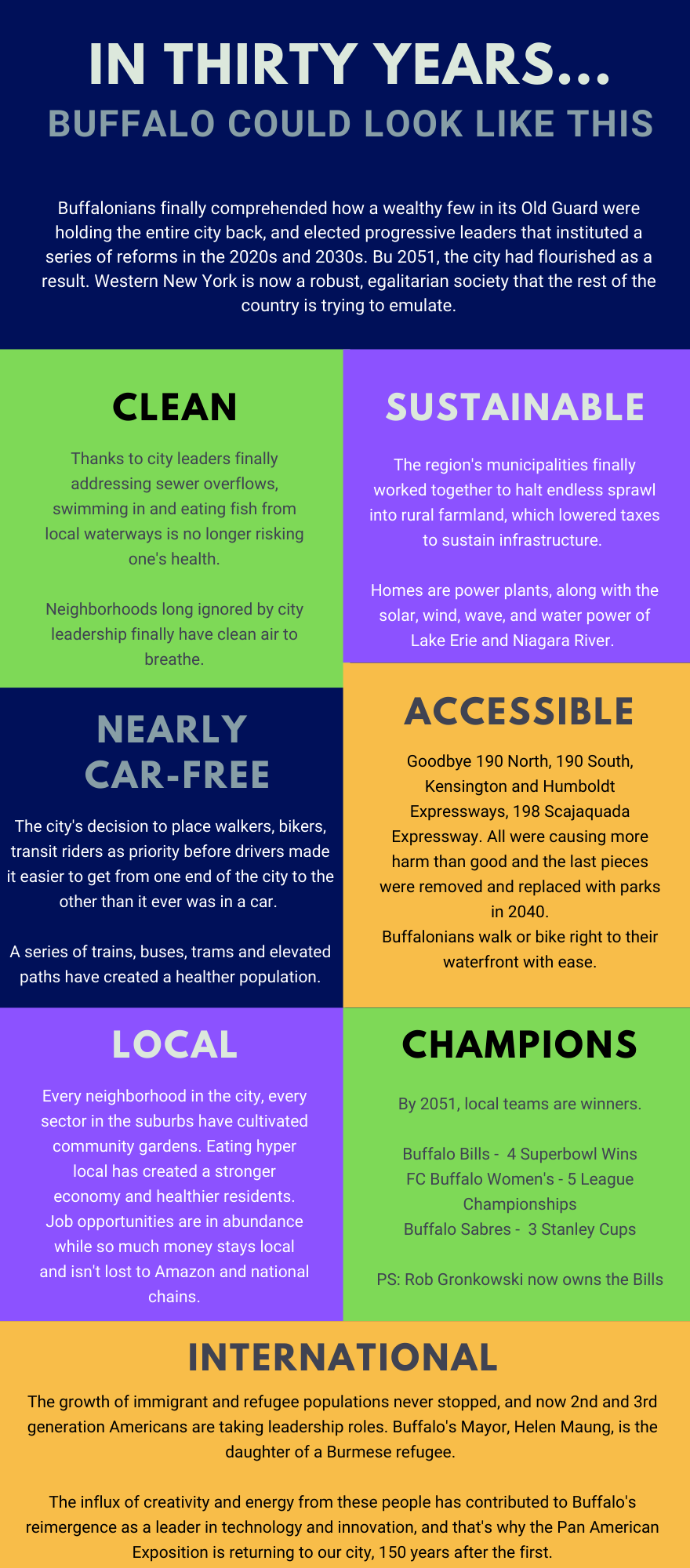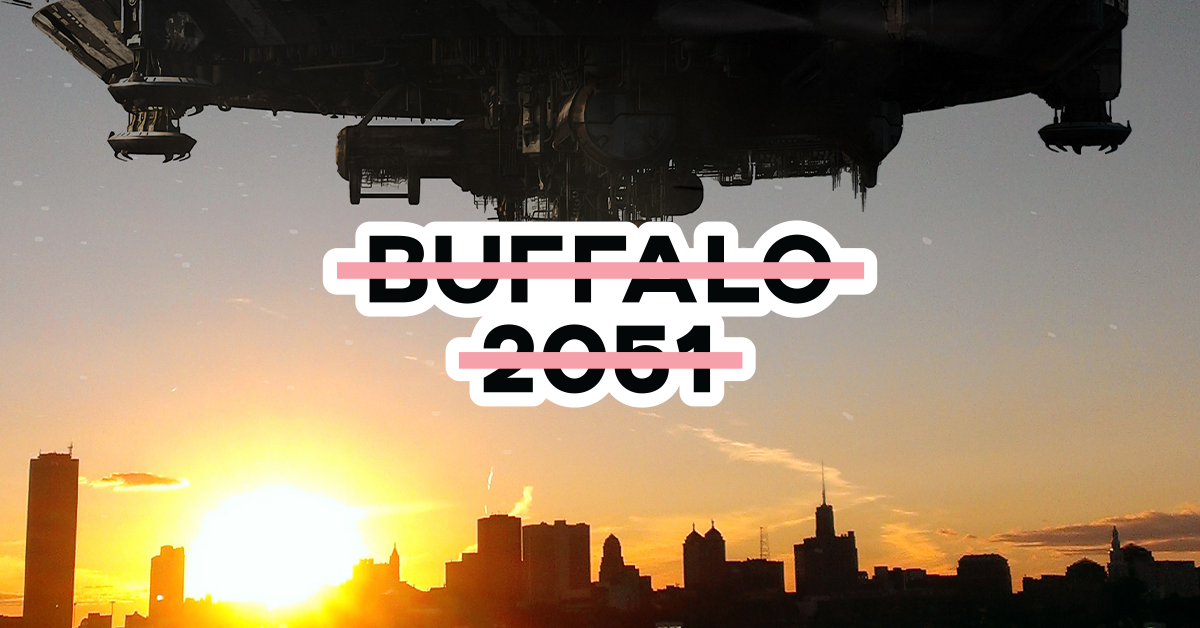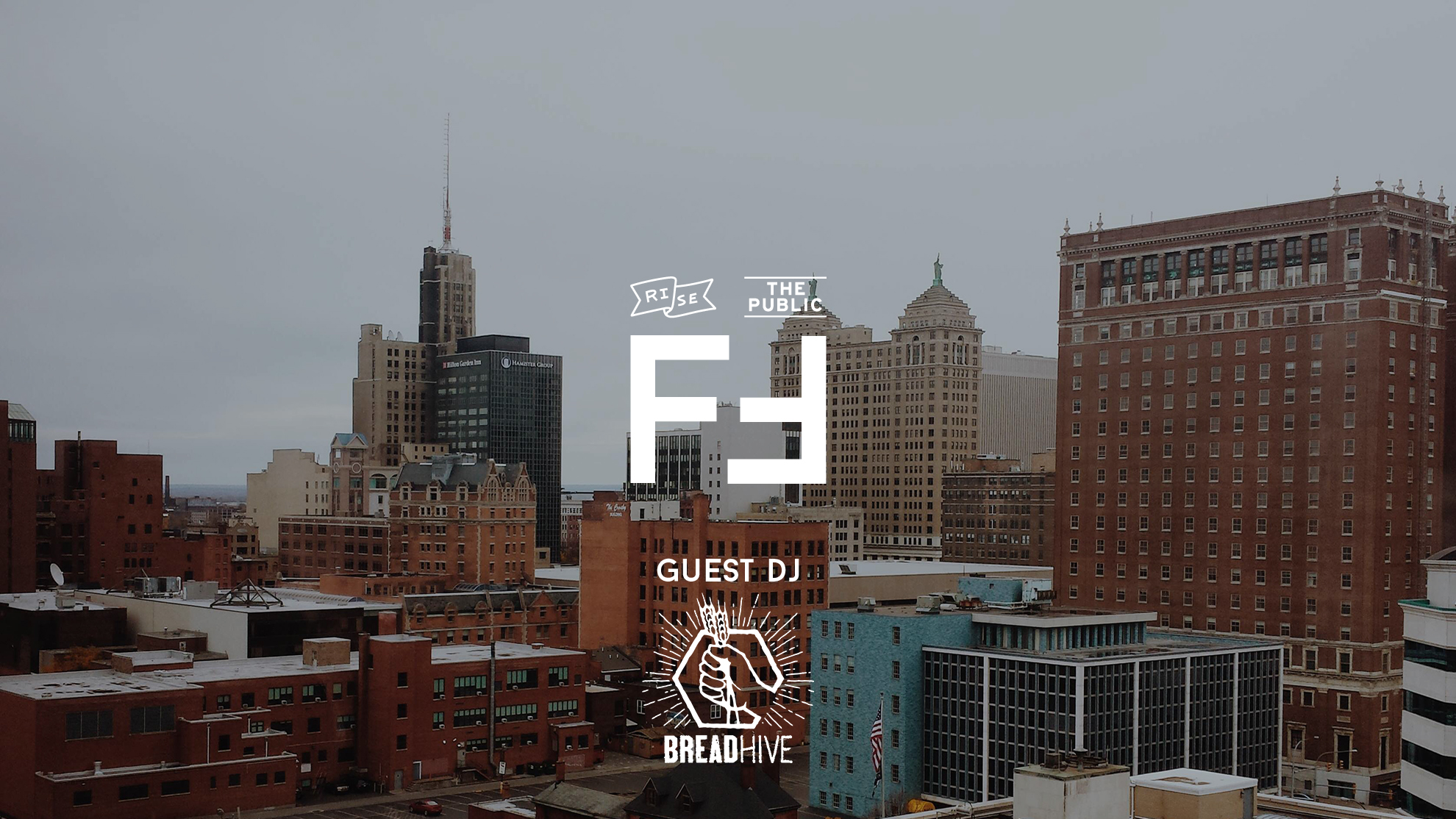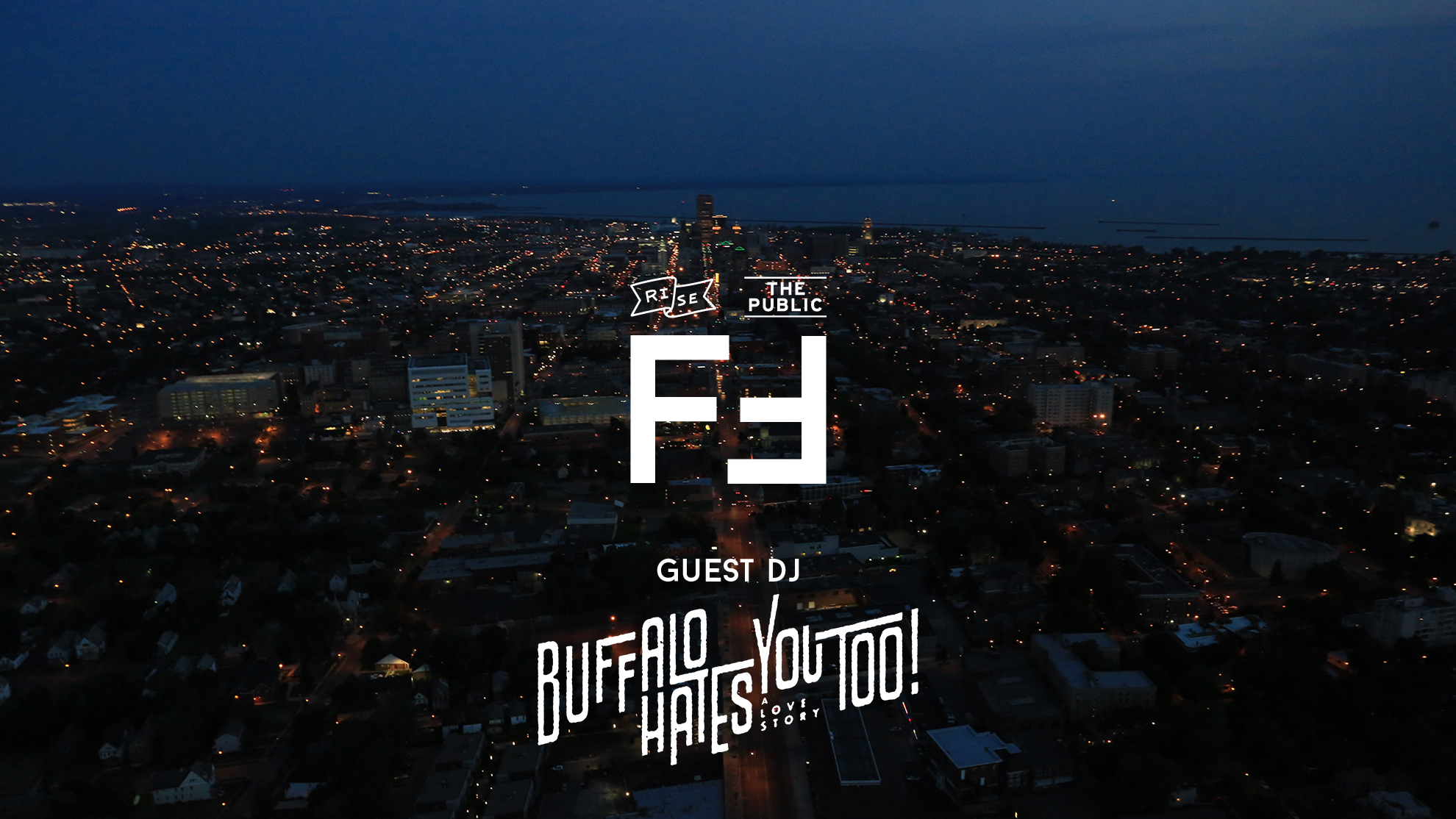WELCOME TO THE FUTURE, BUFFALONIANS!
Thanks for picking up our magazine, presented by West Side Promise Neighborhood, and especially for your additional interest in how it came together. Before writing their suspense, murder, sci-fi and sports stories, the six authors inside were required to read through these basic facts about what Buffalo will look like in 2051. That description of the future was made possible by input from various non profits, researchers and professors throughout the region. Below, check out those basic parameters, and then hear from all those different contributors.

Buffalo Niagara Waterkeeper on the region’s water in 2051
View this post on Instagram
ON IDEA THAT TIES IT ALL TOGETHER: Water Resources are treated with the same reverence as our national parks.
1 – Community Members will be able to swim or play in any of our water bodies, tributaries, lakes, rivers anywhere they want to without getting sick, ingesting any pollutant.
HOW: Eliminate all combined sewer overflows and storm water pollution (gets captured into filtration). (This is definitely something that’s possible, not just utopian. Long-term plans are 20 years and we’re 5 years in.
2 – People could eat the fish they catch in our waterways to sustainably feed their families and have access to the resources we’ve all been denied because of the chemical pollution in the fish.
HOW: Eliminate all legacy pollution. All PCBs from industrial past, carcinogens at bottom of waterways. We did this in Buffalo River. Need to for all tributaries across the river. That would be VERY hard in 30 years, but “ya never know.”
3 – We know our drinking water is safe and protected and everyone believes that, knows it, and they’re not worried about drinking the water coming through their tap.
HOW: We have to build back the trust of entire population. Right now, there are residents in the city of buffalo who for good reason don’t believe their water is safe to drink. Because of decades of environmental racism. There is not a trust in the state or regulatory agencies protecting them. They don’t believe that currently.
4 – Everyone has access to the water – physically easily able to no matter where they live. Also mentally emotionally have access to the water.
HOW: 190 Gone. 33 Gone. 198 Gone. Outdoor environment has not been welcoming to black, indigenous for many reasons. Those Barriers need to be broken down.
5 – Staff and Board of environmental groups have a racial makeup of the entire community that they serve.
HOW:
Groups need to be listening to all constituents and work toward causes that directly affect folks, especially those most vulnerable communities – especially those hit hardest by fossil fuel economy. Big way to gain a more diverse following is to work directly on issues that affect those populations.
See the restored Scajaquada Creek vision right here.
Jericho Road Community Health Center on the region’s refugee’s in 2051
Check out our newest video, hosted by Chief Program Officer Dr. Anna Ireland Mongo and #ViveShelter Director Matt Tice. They chat about Vive’s operations over the past year and explain some of the recent challenges the shelter has faced and overcome. https://t.co/YvG2G9HtFu
— Jericho Road Community Health Center (@JRCHCBuffaloNY) October 1, 2021
ONE IDEA THAT TIES IT ALL TOGETHER: Refugees have the same opportunities as everyone in the city, and that everyone has the opportunity to build and improve their lives.
1 – That refugees will be pulled from cycles of poverty.
HOW: Refugees must get a job within 90 days of arrival. What if we were able to build in more services to allow them to obtain GED, College’s Associates, Bachelor’s degrees that were more flexible around their work schedule? Could 90 days to get a job be doubled, or turned into a year?
2 – Resettlement services are expanded.
HOW: Immediately upon arrival, refugees are thrown into very rapid on-boarding from banking, finding jobs, doctors, schools for their children. If the average adult needs to hear something six times in their native language before fully absorbing it, then this on-boarding process for new Americans needs to slow down and provide more resources. Evening classes to be offered, and therefore more people employed by city/resettlement agencies to provide more opportunities to learn.
3 – Everything publicly funded has a full array of language services.
HOW: Currently the city only relies on 1-2 people who speak foreign languages to conduct a majority of its business, from police to fire to other city services, someone who can translate is called. These service providers need to be expanded to cover the 35+ main languages spoken in Buffalo. Time may solve this as refugee children become working adults, but not if it is not recruited for INTENTIONALLY and CONSISTENTLY.
4 – Refugees can work in the fields they’re qualified for.
HOW: Many refugees, especially from Syria, Iraq, Burma, Iran are highly educated and highly skilled, but they can’t obtain work in their former fields because they lack the documentation that proves their competence. They can’t call up the country they left for fear of death or imprisonment and ask for their documents. So the US should develop new ways to allow highly-skilled refugees to demonstrate their skill sets and qualify for the jobs they used to have.
DANIEL B. HESS’ (Professor and Chairperson, Department of Urban and Regional Planning, University at Buffalo) VISION OF BUFFALO/NIAGARA in 2051
ONE IDEA THAT TIES IT ALL TOGETHER: Smart and connected cities within a smart and connected region
The City of Buffalo and the City of Niagara Falls, along with other cities, towns, and villages throughout Western New York, are envisioned as communities that synergistically integrate intelligent technologies with their built environments (including buildings and infrastructure) and natural environments (land, air, water, and resources). Emerging from this vision are various pathways that can improve the social, economic, and environmental well-being of those who live, work, learn, and travel within our region.
1 – Everyone can participate in open and transparent governance. Citizens and residents are informed and empowered to participate; economic opportunity and growth results and overall quality of life improves. How: new technological tools encourage participation in government; citizens have ready access to information about decision making. Participatory governance allows citizens and residents to take part in shaping the future of their communities.
2 – Access and mobility for all. Various modes of transport facilitate engagement, participation, communication, and exchange of goods and ideas. These modes of transport are accessible to all, regardless of income, and access and mobility supports racial equity and social inclusion. The system should provide safe, convenient, affordable, and sustainable transport. How: reduce reliance on automobiles, improve public transport access, make bicycling and walking more convenient, and engage new technology. Reduce sprawling tendencies in land development; manipulate origins and destination to reduce the need for traveling great distances. Ease travel throughout our region, even across the US-Canada border. In this way, improve accessibility and inclusivity.
3 – Urban sustainability: leave it better than we found it. Contemporary cities and regions have a pivotal role in shaping strategic sustainable development. We can readily strive for sustainable, resilient, and inclusive communities that not only maintain but improve natural ecosystems (Buffalo-Niagara’s land, rivers, gorges, lakes, and forested areas). How: react to threats posed by climate change, conserve resources, and improve ecosystems for future generations. These actions stress resilience and improving resource efficiency.
4 – Rapidly changing technological innovations improves lives. In the future, there should be many examples for Western New Yorkers to see how we can use technology to confront challenges and improve lives. How: information systems help citizens and residents and leaders understand how cities and communities function and how to development implementation strategies to meet community goals.
5 – Health and social factors: creating a healthier community. When health and wellness is improved, the overall quality of life can improve. How: data and technology are used to predict and prevent illness and disease rather than rely on reactive acute treatment. Data sharing among community service providers improves population health management and addresses individual health needs. Create an equitable and just healthcare system. Be prepared for the next pandemic. Remove barriers to healthcare, redress inequities between racial groups, incomes groups, and geographic areas (city vs suburb, East Side vs West of Buffalo, etc).
Kristin Heltman-Weiss of Providence Farm Collective on WNY’s Food Production System in 2051
ONE IDEA THAT TIES IT ALL TOGETHER: Food Scarcity/food insecurity in the region’s marginalized communities will be eliminated. Food will be a human right:
-
- Through collaborative projects and consolidation and sharing of resources (such as education, training, cold storage, delivery, markets, distribution, purchasing, urban and rural farmland, transportation) collaborative organizations like Providence Farm Collective (PFC), comprised of Somali Bantu Community Farm, Buffalo Go Green, Feed Buffalo, Buffalo Food Equity Network, WEDI/West Side Bazaar, Community Action Organization of WNY, FeedMore of WNY, Cornell Cooperative Extension, Congolese Babondo Buffalo, the immigrant and refugee community of Our Lady of Hope, Grassroots Gardens, Massachusetts Avenue Project, African Heritage Coop, Blegacy Farm, and other nonprofit agencies in the region’s food system will empower under resourced individuals to grow their own food and feed their communities.
- The continued growth of farming more land, the addition of hydroponics and greenhouses in the city, and farming more efficiently at Providence Farm Collective, Grassroots Gardens, Buffalo Go Green and Community Action Organization will significantly increase the production of organically grown vegetables and fruits specifically for distribution in communities located in food deserts.
- Double Up Food Bucks benefits will provide a way for organizations and farmers to offer CSAs and direct sales to SNAP recipients, without having to go through farmers markets. Institutional and bureaucratic barriers to access to fresh foods for all will be eliminated.
Farmland inequity/inequality will be eliminated:
-
- Collaborative farming projects like PFC will own their land and offer tenancies to under resourced farmers in perpetuity.
Farming for all will be economically sustainable for farmers:
-
- Western New York’s state, county and local governments will develop a better transportation system to provide ease of access to farmland and outdoor recreation in the region.
- Improved, affordable and coordinated delivery and storage of fresh foods will decrease waste and ensure that the freshest produce reaches those in need of it in a timely manner.
- Under-resourced farmers – all farmers – will be offered fair and equitable wages with benefits and pricing for their produce that values their work and the land.
- Under-resourced farmers will be full participants in the region’s food system. Access to all markets, including institutional markets, will be improved and barriers eliminated.
Region will invest in and support local farmers, including those operating small farms, and the development of local fresh food processors:
-
- Fast food restaurants will be replaced with fresh food restaurants that focus on serving affordable meals that are made with only fresh, nutritious, affordable and locally sourced ingredients.
- Fresh fruits and vegetables will be grown locally and will be easily available and affordable, thus increasing their overall consumption.
- WNY leaders in business, education and government will support improvements in the overall food system and make eating local and fresh foods a priority through legislation (in the form of a tax on fast food, junk food, sugary foods, highly processed foods or tax-free development zones for farms and businesses that support eating local, healthy and fresh).
- In light of climate change and its anticipated disruptions in food systems across the world, leaders in business, nonprofits, education and government will prepare all WNYers by educating about importance of having a strong local and healthy food system. Create programs that support economic and educational connections between consumers and farmers.
- Create a food processing hub and agriculture jobs development program (size of Northland Corridor) that is committed to serving our local communities and strengthening the local food and farm systems.
- Regional government will create legislation that will protect farmland from urbanization.
- Businesses and industries, such as Moog or Calspan, will work with local farmers to develop automated equipment and methods that support efficiency and increased output in farming, to make small farms more economically sustainable.
- Rather than instigate competition for funding among agencies and organizations in the food system, local foundations and governmental funding agencies will support systems rather than individual organizations – the idea that putting oneself out of business because food scarcity, food insecurity and land inequity have been eliminated should be the ultimate goal of any nonprofit or for-profit agency committed to marginalized communities.
- Small farms and their farmers will be supported as equally as their large, industrial counterparts by businesses, universities/colleges and regional governments.
- Although there has been a slight increase in awareness of the need for a just food system, by 2051, a completely just system will be in place in the Buffalo Niagara region for the world to emulate.
Region will commit to plan to eliminate sprawl, and maintain, as well as nurture/develop prime farmland:
-
- Local and state governments will work together to develop and implement a plan to contain urban sprawl and foster the health of the region’s farmland.
- Local state parks, such as Knox Farm State Park and county parks, such as Emery Park, will provide farming opportunities for under resourced communities.
- Local government agencies will support farming as an economic development tool in the region.
Dr. Elizabeth K. Thomas—Assistant Professor—Department of Geology—University at Buffalo on energy consumption
UB ice scientist among authors of new IPCC climate change report https://t.co/JoLE9MxKG9
— UB Dept. of Geology (@UBGeology) September 7, 2021
ONE IDEA TO TIE IT ALL TOGETHER: We have completed a rapid, just, and sustainable transition to low-carbon energy sources.
Buffalo has helped lead developments in carbon sequestration, both through engineering solutions, and through protection, preservation, and renovation of green spaces, including parks, farms, and wetlands. Buffalo leads the nation in several realms that contribute to energy independence and support thousands of regional jobs:
-
- renewable energy production (via hydro-, wind- and solar power),
- green hydrogen fuel production (which has replaced natural gas),
- energy storage (via water and compressed air techniques that do not require chemical batteries), and
- large-scale chemical battery recycling, precluding a need for extractive mining of rare earth and heavy metals in developing nations.
As a result of our regional, national, and global efforts, heat-trapping gas concentrations in Earth’s atmosphere are stabilizing.
Here in Buffalo, winters are warmer than they were 100 years ago, with fewer days of ice-cover on Lake Erie, and as a consequence the couple of polar vortex events that occur each winter result in large lake effect storms. Rather than snow, much of the winter precipitation falls as rain. In addition, summers are hotter, with a few days each year even reaching 100°F. But during our just transition to low-carbon energy sources, all homes, schools, businesses, and government buildings were weatherized and connected to energy-efficient geothermal heating and cooling systems. So, despite the weird weather, everyone stays comfortable in their homes and workplaces year-round and still has reasonable energy bills.
Because summers are hotter, we now need to irrigate farm fields, rather than depending on rain only, to keep them from drying out. But we have adopted agricultural practices that enrich and retain soil carbon and nutrients (further drawing down atmospheric heat-trapping gases!), rather than causing major nutrient runoff into the Great Lakes. As a result, the Great Lakes no longer experience Harmful Algal Blooms, and so we can safely use this water to irrigate our farms. We have also added farms in open spaces throughout Western New York, providing jobs and safe, healthy, affordable, and local vegetable-based diets for every neighborhood in the region.
There is very little food waste, and minimal food insecurity. Reducing food waste, and shortening food supply chains to depend on and support local farms, has been a key step towards reducing our region’s heat-trapping gas emissions.
Despite the recent climate warming, thanks to efforts to draw down heat-trapping gases in the atmosphere, climate models project that temperature and precipitation conditions will begin to slowly return to previous normals (winters below freezing, warm and beautiful summers), making Buffalo an increasingly comfortable place to live. Parents reminisce about playing pond hockey each winter, but because ponds no longer freeze over, they can’t do this with their kids. Luckily, when today’s children grow up, they look forward to playing pond hockey each winter with their kids, which climate models project will be possible!
Everyone can enjoy green spaces, filled with native birds, bugs, bats, amphibians, reptiles, plants, and other wildlife, that they can walk or bike to from their home. Everyone can commute safely to work on foot, by bike, e-bike, or public transit, with passenger vehicle traffic reduced.
P-12 school curriculum takes advantage of the green spaces that are adjacent to every school, and students spend at least half of their school days learning outdoors. As a result of all this outside time, physical and mental health has improved among children in the region.
All new and recently re-roofed buildings have solar panels, with two positive by-products: 1. household, public school, and business electricity bills are minimal, and 2. Green spaces and farmland can remain as such, and have not been converted to large-scale solar fields.
We have done an excellent job of figuring out how to reduce solid waste from homes and businesses. Everyone composts all organic waste and recycles all soft and hard plastics, glass, paper, and cardboard. As a result, the cans that we put on the curb for weekly pickup are a tiny trash bin, a medium compost bin, and a large recycling bin. Most households and businesses don’t even put their trash bin out every week, because they generate so little trash.
RESTORE OUR COMMUNITY COALITION: Vision for Buffalo-Niagara 2051
Bradley J. Bethel Jr.; ROCC Research Associate
ONE IDEA TO TIE IT ALL TOGETHER: A New Humboldt will Reconnect City Parks, Replenish City Neighborhoods, and Repair City Resources
A newly restored Humboldt Parkway will provide a lush, green path for residents of the Hamlin Park neighborhood.
Three miles, roughly 39 linear acres will reconnect Martin Luther King Park with Delaware Park, serving as the heart of both Buffalo’s East Side and the Olmsted Parks & Parkway System.
In step with the 2014 Economic Impact Statement, Hamlin Park will havesuccessfully replenished decades of lost values and investments.
The sordid legacy of redlining and active disinvestment will be long gone. Home prices will appreciate in respect to a community land trust (as exhibited in the present-day Fruit Belt) and present-day homeownership.
The influx of new mom-and-pop shops in the Jefferson and Fillmore Avenue Business Districts will keep college students in Buffalo upon graduation, in kind helping to reduce decades of city poverty. Estates can be passed down to children and grandchildren, as urban inheritance will be realized among African American families.
The noise and air quality will dramatically improve around the target area of a new Humboldt Parkway.
Residents of Humboldt Parkway will no longer awaken to the roar of expressway traffic. Carbon fumes will be replenished with oxygen supplied from the trees. Temperatures will stabilize during the warm summer months and the cold winter months.
The new Humboldt median will serve as a year-round respite for the neighborhood.
Not unlike Bidwell Parkway, the new median will provide a picturesque landscape throughout each year. Trees will provide refreshing shade during summer days. Potential new festivals could be held; The Museum of Science could host outdoor events on the foot of Humboldt Parkway.
A new Humboldt will reunite severed neighborhoods.
Little-known logistic factors caused by the present-day Route 33 Expressway will also be resolved. Residents can meet families and friends across the green median. The long-secluded Trinidad Neighborhood will be reintegrated into the greater street grid. In fact, residents of Trinidad will be able to make a simple walk to the Em Tea Coffee Cup Café (80 Oakgrove Avenue).
GOBIKE BUFFALO’S VISION OF BUFFALO/NIAGARA 2051’s PUBLIC AND PEDESTRIAN INFRASTRUCTURE
View this post on Instagram
ONE IDEA THAT TIES IT ALL TOGETHER: Our transportation system is designed to benefit the community, and streets are designed to meet the needs of ALL community members.
1- Every street feels like a walk in the park: people are safe from injury and fatality from traffic violence, harassment from police is gone, and access is comfortable and easy.
How: Streets are designed for people of all ages and abilities, not just vehicles. Pedestrian comfort and safety are used instead of vehicular level of service as the leading metric of success in street design. Funding is reallocated from traffic enforcement and police presence to self-enforcing streets and community beautification efforts. Trees and gardens abound while in winter our sidewalks are cleared.
2- Every single person enjoys the same level of access, no matter their income, race, age, physical abilities, or mode used for travel. Travel is a right, not a privilege, and we have worked together to ensure it’s a right shared equally by everyone. The success of our transportation system is measured by how well it connects people to jobs, healthcare, and other basic needs.
How: We started by investing first and foremost in our systemically disinvested, historically ignored communities, like east Buffalo. Community members and people of color are in positions of leadership making infrastructure decisions that affect their neighborhoods. Instead of building wider streets, we rebuilt our public transportation infrastructure, including NFTA’s bus and train system, and Amtrak’s connections between Buffalo and Niagara Falls.
3- Everyone can access our boundless trails and greenspace, and every community enjoys our fully connected trail network and the destinations to which they link. A day trip to Canada or Lake Ontario’s beaches are quick e-bike trips away. We’ll elevate our legacy of Olmsted’s park system rather than Moses’ highway system, and embrace our region’s bountiful natural resources including Niagara Falls, Lake Erie’s shoreline, and our glaciated landscape.
How: All bicycle master plans, including the Buffalo-Niagara Bicycle Master Plan, the City of Buffalo Bicycle Master Plan Update, the City of Niagara Falls Bicycle Master Plan, the Southern Tier Trail Feasibility Study, the New York State Multi-Use Trails Master Plan will be funded and built.
4- Our community members are healthy and happy because our built environment encourages rather than deters physical activity, which boosts our brains and bodies. Because active transportation has been embraced, transportation is no longer the leading sector of climate change in New York State or nationally, and we’re able to welcome climate refugees without increasing congestion, single-occupancy vehicle trips, or the need for parking.
How: Funding and resources are dedicated to improving public transportation, integrating existing options like bikeshare and buses to improve the current services, and embracing new technologies to further address transportation barriers.
5- Urban highways are obsolete, and we cringe at the thought that they were ever considered prudent. Together, we’ll shake our heads–can you believe we ever valued asphalt and seconds of travel time over community members, blue and green spaces, and our economy?!
How: One by one, every urban highway will be removed or infilled reconnecting our radial street grid to our most valued assets regaining our moniker as the Best Designed City.. The Scajaquada and Kensington Expressways will be the first to go. Air, land, and noise pollution will significantly reduce commutes that once seemed impossible by foot or bike will be embraced, our health improved, and segregation eliminated.
Open Buffalo’s vision for Racial Equity in Buffalo 2051
View this post on Instagram
ONE IDEA TO TIE IT ALL TOGETHER: We envision a Buffalo where life expectancy isn’t predicted by zip code. To achieve this, Buffalonians need access to quality education, clean air and water, affordable housing in safe neighborhoods. This Buffalo is possible, but we need political and civic leaders with the vision and tenacity to make it happen.
In 2051, the civic and political leadership in Buffalo reflects the racial, gender, age, and economic diversity of our region. We have removed the barriers to entering into leadership by:
-Public Financing of elections to ensure all people have the resources to participate in our democracy
-federal legislation to protect and expand our voting rights and democracy
-workforce development that has specific equity, diversity and inclusion goals that aims to diversify corporations, and public/private boards
-civic education and participation
In 2051, our neighborhoods are safe and racially diverse. We have achieved this by:
-George Floyd Act:To hold law enforcement accountable for misconduct in court, improve transparency through data collection, and reform police training and policies.
-Funding community based non violence and youth programming
-Developing a localized, comprehensive affordable housing strategy; that protects existing cultural assets that’s sustainable and eco friendly.
DRUG USE
By 2051, Buffalo and the United States will finally have adopted a system similar to that of Portugal today. Where all drugs are legal, but not necessarily widely available or widely in use.
Rather than building the entire drug policy around incarceration, ostracizing those with addiction, and negative stigma, those who develop a problem with drugs will be cared by for society, welcomed into treatment centers, and put back on their feet.
EDUCATION
The most severe problems that appear in our public schools are not really education problems but rather symptoms of the extreme, concentrated poverty in Buffalo and Niagara Falls. Even so, major improvements in public education are possible, starting with universal, quality pre-kindergarten, enhanced after-school programs, more equitable financing for high-needs schools, expanded literacy programs, improved workforce training, and more affordable higher education opportunities.
By 2051, these policies enacted have created a robust public school system that caters to its students needs, develops their strengths, and finally, adequately prepares all students for work or higher education.
The outcome is that Buffalo’s poverty level is on the decline and wealth and opportunity are spread more evenly throughout the city.
CRIMINAL JUSTICE
Most of the serious crime in the region is committed against people living in concentrated poverty. The most effective crime-prevention strategy is an anti-poverty strategy. We also need a major new emphasis on community policing, rehabilitation, reentry, restorative justice, and juvenile diversion programs to reduce the rate of recidivism and offer pathways of hope.
By 2051, these policies enacted have reduced poverty and increased opportunity throughout the city. Recidivism is at its lowest rate in history, and those that do commit a crime are actually rehabilitated and welcomed back into society. The term to use is “Returning Citizens” rather than “Ex-Convicts.”
Dr. Barbara Wejnert, Associate Professor- Transnational Studies, University at Buffalo, SUNY Vision for Women in 2051
ONE IDEA THAT TIES IT ALL TOGETHER: Women will be respected figureheads pioneering change that cares for communities and the planet.
Women will continue to grow to be more visible in non-governmental leadership roles, raising the collective consciousness about gender equality and sustainable living.
More women will move into legislation—locally, nationally and internationally—making policies and changes that benefit not only for themselves, but mainly for others and their community since by their nature women are often more connected to people and their families.
Women will essentially have equal pay and job opportunities, comparable to the current Scandinavian countries. As more policies are made that protect women and children, like better maternal health provisions and education equality, alongside more men empowering women when they themselves have daughters, the status of women and girls in Buffalo will rise.
Family life and responsibilities will be equally shared between men and women. Men and women will be given equal family leave time and be required to take it. Smaller families (two children or less) will be more prominent. As a result, divorce rates will be lower, as women will likely marry later in life and be in more equal partnerships as equal caretakers and providers.
Women will champion a much more humane approach to living, forgoing our often current nervous lifestyle for a sense of much more stability and peace.
Shannon Eaton, Owner of Blue Pepper Farm on Sustainability
View this post on Instagram
Why/how did you start the wool component with the Hudson Valley Textile Project?
When we decided to start milking our sheep, we switched from raising Katahdin hair sheep exclusively for meat to East Friesian dairy sheep. Since these are wool sheep, we ended up with two additional products – tanned sheepskins from our lambs and wool from our ewes. When we first had our sheep’s fleeces spun into yarn, we were pleasantly surprised with the results, being softer than we hoped. We’ve gone on to collaborate with an incredibly talented weaver, Lilly Marsh, on a cloth project and woven blankets. We’ve also worked closely with Mary Jeanne Packer at Battenkill Fiber Mill. Both of these women worked hard to create the Hudson Valley Textile Project and I’ve been lucky to work with and learn from them.
No Boundaries Magazine 8: This magazine edition will feature a“Utopian” Buffalo in 2051 with fictional essays based on realistic predictions of the future. Think: what if everything goes in the best direction it can? What are those components?
Zero fossil fuel use – electric farm machinery charged by solar/wind power, geothermal heating systems in homes and greenhouses. Black and Indigenous land owning farmers leading the way in regenerative agriculture, with perennial foodstuffs and native animals/fish thriving in healthy habitats. Farmers/stewards making a liveable wage. This ecological farming replacing extractive agriculture and scaling up in a way that brings affordable good food to the masses along with invaluable ecosystem services provided by intact functioning regional ecosystems.
From an agriculture and/or slow fashion perspective: Clothes are all sewn from agricultural products – wool, cotton, alpaca, linen, angora, hemp, silk, etc. No production of new polyesters or other synthetic fabrics derived from petroleum – recycled only. Sewing/mending/fiber arts taught to all students in school and encouraged as a means of self expression. A cultural 180-degree turn away from throwaway conveniences and hyperspeed trend cycles, and towards pride in and appreciation for quality clothing worth mending a hundred times. And when it can’t be mended anymore, it can be composted. If you can’t compost your own, there would be a municipal system for composting, available to everyone and to the benefit of everyone (for example, used to fertilize public pollinator gardens to beautify our communal spaces).
What are some things you think or hope might be likely to be the “norm” in 30 years time?
Reused clothing, democracy, B-corps, mondragon collectives
What is the “ideal” future?
Diminished income inequality, increased equality across all demographics
If we do all the things that could make life better for agriculture/sustainability what are those outcomes in 30 years?
Stable atmospheric CO2 levels and other anthropogenic greenhouse gases, highly reduced air/water/soil pollution, no more desertification, biodiversity loss, habitat destruction. Reinvigorated domesticated animal and plant (and wild) biodiversity with public ownership of genetics, no patenting of life. Top soil depths growing world wide and increasing levels of soil carbon. Global human population adjusting to sustainable levels relative to consumption/efficiency etc. Land ownership and control of ag reaching a much higher percentage of the populous. The dissolution of major ‘conventional’ ag companies. Labor and immigration laws to protect all folks, livable wages, growing cultural respect for food producing land stewards. Fisheries recovering and managed sustainably.Wetlands and coastal areas protected and managed by traditional peoples.




